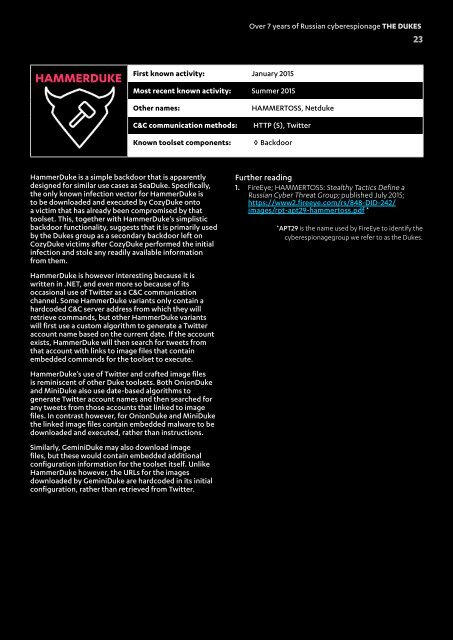THE DUKES
KfG7I6
KfG7I6
Create successful ePaper yourself
Turn your PDF publications into a flip-book with our unique Google optimized e-Paper software.
Over 7 years of Russian cyberespionage <strong>THE</strong> <strong>DUKES</strong><br />
23<br />
HAMMERDUKE<br />
First known activity: January 2015<br />
Most recent known activity: Summer 2015<br />
Other names:<br />
C&C communication methods:<br />
Known toolset components:<br />
HAMMERTOSS, Netduke<br />
HTTP (S), Twitter<br />
◊ Backdoor<br />
HammerDuke is a simple backdoor that is apparently<br />
designed for similar use cases as SeaDuke. Specifically,<br />
the only known infection vector for HammerDuke is<br />
to be downloaded and executed by CozyDuke onto<br />
a victim that has already been compromised by that<br />
toolset. This, together with HammerDuke’s simplistic<br />
backdoor functionality, suggests that it is primarily used<br />
by the Dukes group as a secondary backdoor left on<br />
CozyDuke victims after CozyDuke performed the initial<br />
infection and stole any readily available information<br />
from them.<br />
HammerDuke is however interesting because it is<br />
written in .NET, and even more so because of its<br />
occasional use of Twitter as a C&C communication<br />
channel. Some HammerDuke variants only contain a<br />
hardcoded C&C server address from which they will<br />
retrieve commands, but other HammerDuke variants<br />
will first use a custom algorithm to generate a Twitter<br />
account name based on the current date. If the account<br />
exists, HammerDuke will then search for tweets from<br />
that account with links to image files that contain<br />
embedded commands for the toolset to execute.<br />
HammerDuke’s use of Twitter and crafted image files<br />
is reminiscent of other Duke toolsets. Both OnionDuke<br />
and MiniDuke also use date-based algorithms to<br />
generate Twitter account names and then searched for<br />
any tweets from those accounts that linked to image<br />
files. In contrast however, for OnionDuke and MiniDuke<br />
the linked image files contain embedded malware to be<br />
downloaded and executed, rather than instructions.<br />
Similarly, GeminiDuke may also download image<br />
files, but these would contain embedded additional<br />
configuration information for the toolset itself. Unlike<br />
HammerDuke however, the URLs for the images<br />
downloaded by GeminiDuke are hardcoded in its initial<br />
configuration, rather than retrieved from Twitter.<br />
Further reading<br />
1. FireEye; HAMMERTOSS: Stealthy Tactics Define a<br />
Russian Cyber Threat Group; published July 2015;<br />
https://www2.fireeye.com/rs/848-DID-242/<br />
images/rpt-apt29-hammertoss.pdf *<br />
*APT29 is the name used by FireEye to identify the<br />
cyberespionagegroup we refer to as the Dukes.


